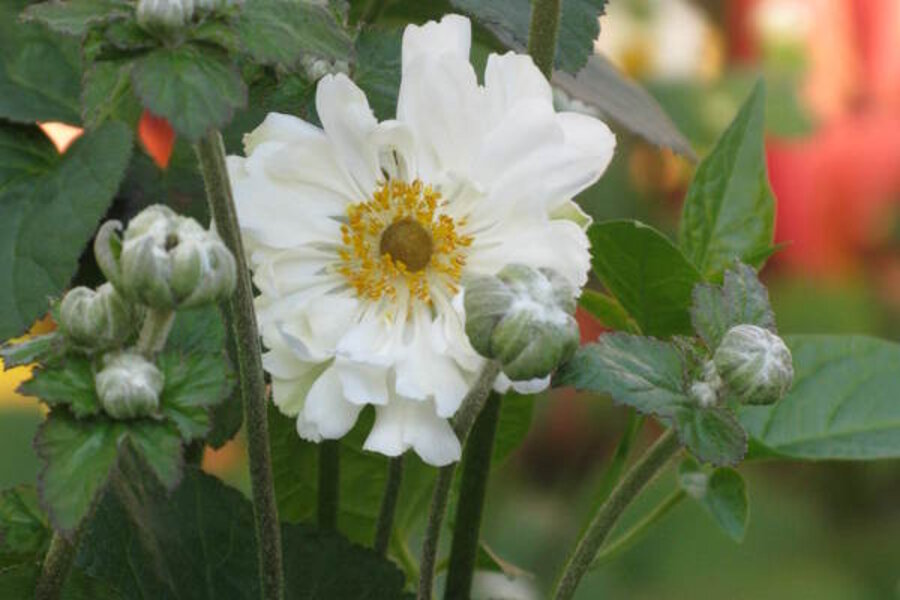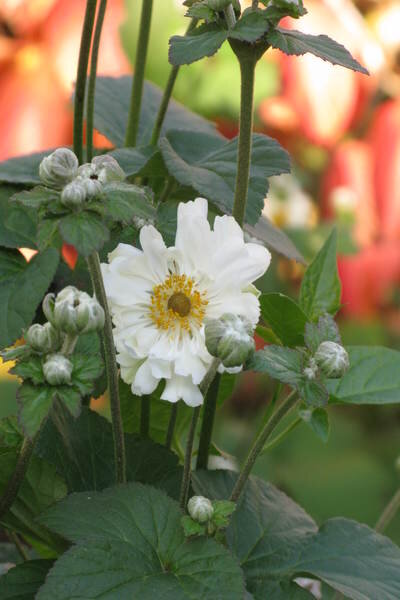Fall-blooming anemones
I confess! In most instances, good cultural advice is the primary goal of these blog posts. But sometimes, just sometimes, an opportunity presents itself that I just cannot ignore. So I go against my own advice.
Yesterday, as late as it is in the growing and planting season here in northern Illinois, I came across a few plants in gallon containers at a house sale, each marked at a measly $1 a pot.
Yes, a buck apiece!
Fall-blooming windflowers, Anemone ‘Whirlwind’ -- 10 pots for a mere 10 bucks. How could I walk away? Even though this is definitely the wrong time of the year to plant these fall bloomers (anemones are best divided or transplanted in the spring), this was a chance I had to take.
Why?
Because these prolific bloomers are perfect for illuminating a garden’s shaded nooks and crannies. ‘Whirlwind’, a compact plant with large, white flowers that start blooming in late August and continue the show into October, is nothing short of a true eye-catching conversation plant in the autumn garden.
And the plants that I found on sale, though dormant in their pots, upon closer inspection showed healthy looking roots.
Definitely worth the $10 risk, I thought.
A serious garden treasure
These particular windflowers, also known as Japanese anemones, are prolific bloomers. Standing about 3 feet tall, they are the perfect backdrops for shorter asters, mums, and other garden plants.
The two-to-three-inch wide blossoms – ruffled, semi-double white petals surrounding frilly yellow centers – that rise atop willowy stems are poppylike in appearance. Silky, cup-shaped petals blooming atop long, graceful stems that sway above clumps of dark green, maplelike foliage, always lend a breath of fresh air to tired fall gardens. (You may also find Japanese anemones [PDF] with pink or violet flowers.)
Though the long stems looks delicate, they are quite strong and don’t need to be staked. During the spring and summer months, the foliage is an attractive green addition to the garden, but come fall, the plant’s glossy green leaves turn a reddish hue bringing a refined and elegant touch of beauty to an autumn landscape.
Hardy to Zone 5, Japanese anemones flourish in light to partial shade, but are known to tolerate full sun as long as there is sufficient moisture. However, in hot, dry summer conditions, foliage does tend to burn a bit, which, while it doesn’t hurt the plants, makes your bed look a bit on the sloppy side.
While they can be grown in most soils, they appreciate soil that is humus-rich and moist, but well-drained. Planting anemones in soils that remain water-logged in winter is akin to a death sentence for these beauties.
Growing advice
I have found that in my Midwestern yard, I need to plant anemones in a protected spot, such as that afforded by a wall or dense clump of shrubs. Mulching, especially the first couple of years, is definitely beneficial.
Though it isn’t necessary to divide these plants very often, if you must divide or move plants in the garden, do so only in the spring. Fall anemones may be slow to establish, but once they have settled in, they have a tendency to spread somewhat. Deadheading won’t prolong bloom, but it will make plants look neater.
As for pests, the only problems I’ve encountered are Japanese beetles, which devour them with a relish. Although I am fortunate to note that I don’t have any deer problems, if you do, know that these gorgeous blossoms are deer resistant – another reason to love this plant.
So with a “heat spell” predicted for the end of the week, you’ll find me out in the garden, planting 10 pots of treasured perennials. Yes, it is uncertain whether they’ll survive our crazy winters. But sometimes, a gardener just has to have some faith!
-----
Betty Earl, the Intrepid Gardener, is one of more than a dozen gardening experts blogging regularly at Diggin' It. Her latest book is 'Fairy Gardens: A Guide to Growing an Enchanted Miniature World.' She writes a regular column for Chicagoland Gardening Magazine and The Kankakee Journal and numerous articles for Small Gardens Magazine, American Nurseryman, Nature’s Garden, and Midwest Living Magazine, as well as other national magazines. She is a garden scout for Better Homes and Gardens and a regional representative for The Garden Conservancy. To read more by Betty here at Diggin' It, click here.







